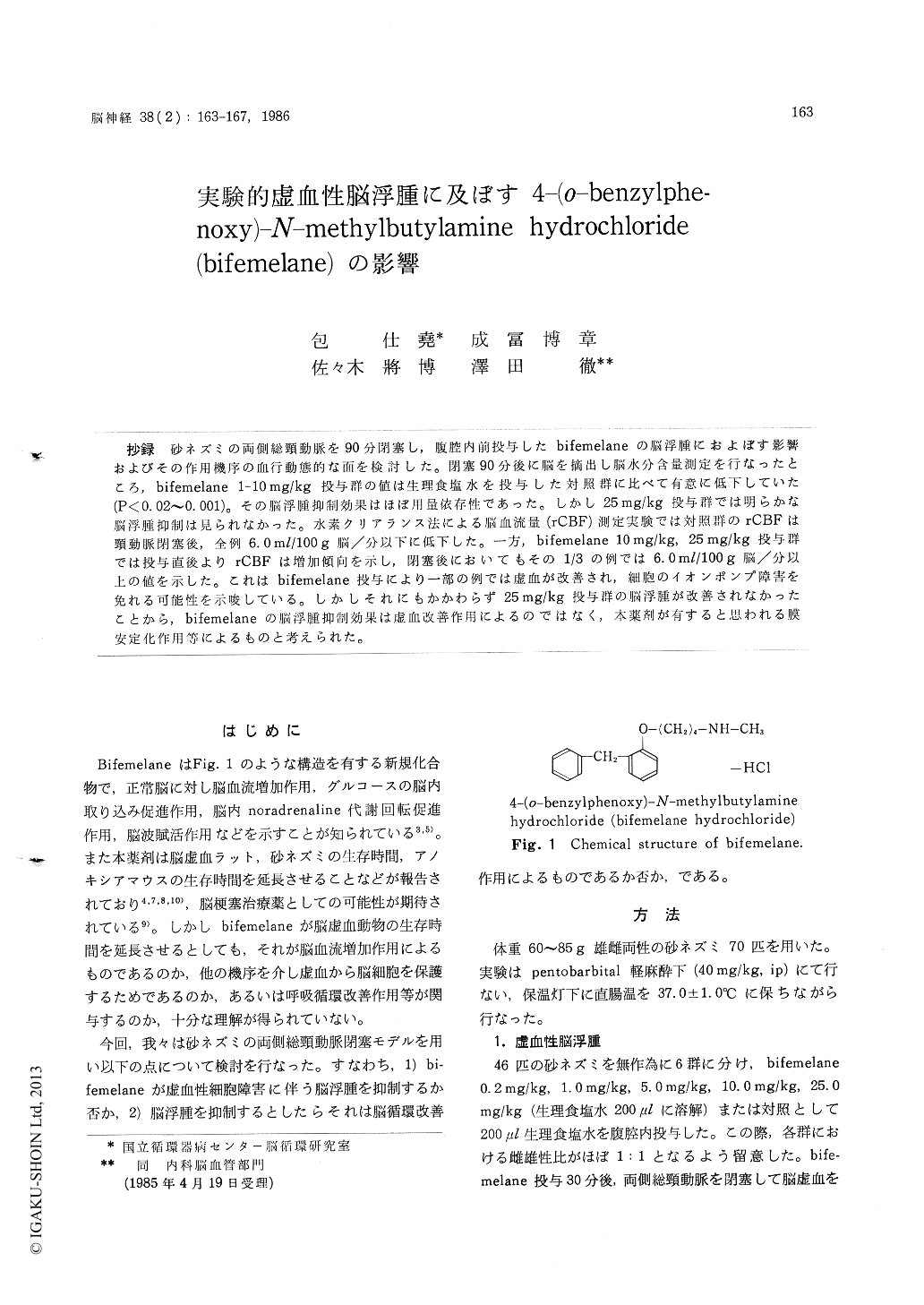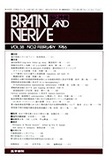Japanese
English
- 有料閲覧
- Abstract 文献概要
- 1ページ目 Look Inside
抄録 砂ネズミの両側総頸動脈を90分閉塞し,腹腔内前投与したbifemelaneの脳浮腫におよぼす影響およびその作用機序の血行動態的な面を検討した。閉塞90分後に脳を摘出し脳水分含量測定を行なったところ,bifemelane 1-10mg/kg投与群の値は生理食塩水を投与した対照群に比べて有意に低下していた(P<0.02〜0.001)。その脳浮腫抑制効果はほぼ用量依存性であった。しかし25mg/kg投与群では明らかな脳浮腫抑制は見られなかった。水素クリアランス法による脳血流量(rCBF)測定実験では対照群のrCBFは頸動脈閉塞後,全例6.0ml/100g脳/分以下に低下した。一方,bifemelane 10mg/kg,25mg/kg投与群では投与直後よりrCBFは増加傾向を示し,閉塞後においてもその1/3の例では6.0ml/100g脳/分以上の値を示した。これはbifemelane投与により一部の例では虚血が改善され,細胞のイオンポンプ障害を免れる可能性を示唆している。しかしそれにもかかわらず25mg/kg投与群の脳浮腫が改善されなかったことから,bifemelaneの脳浮腫抑制効果は虚血改善作用によるのではなく,本薬剤が有すると思われる膜安定化作用等によるものと考えられた。
Effects of the new chemical agent, bifemelane, on ischemic cerebral edema were studied in 70 mongolian gerbils. Five different doses of bifeme-lane (0.2-25.0 mg/kg) as well as saline were admi-nistered intraperitoneally in 6 groups of animals (n=46), and 30 min afterward both common caro-tid arteries were occluded. The brain was re-moved 90 min after the occlusion, and the cerebral water content (CWC) in the bifemelane treated groups and the controls was compared. To assess hemodynamic effects of bifemelane, regional ce-rebral blood flow (rCBF) was also measured in 24 animals using hydrogen clearance techniques.
The CWC in the saline-treated controls (79.9± O.4%) was significantly increased compared to the normal values (78. 4±0.3%). The CWC in the groups receiving 1 mg/kg, 5 mg/kg and 10 mg/kg of bifemelane showed 79.3 ± 0.3%, 79.5 ± 0.2% and 78.9±0.3%, which were significantly lower than the controls (p <O.005, p<0,02, p <O.001). Thus, bifemelane reduced a development of ischemic cerebral edema in a dose-dependent manner.
The rCBF in the bifemelane groups and the controls measured before the drug administration was the same ranging within 35.0-37.0 ml/100 g brain/min. The administration of bifemelane pro-duced small rCBF increase. After the carotid artery occlusion, rCBF in all control animals decreased below 6.0 ml/100 g brain/min, the cri-tical level for cellular ion-pump function. The majority of bifemelane-treated animals also showed a similar flow reduction. However, in 33% of animals receiving 10 mg/kg or 25 mg/kg of bife-melane, rCBF was maintained above this critical level.
The results of the present study suggest that bifemelane may have suppressive effects on ische-mic cerebral edema. Judging from the fact that cerebral edema was most remarkably depressed in 10 mg/kg group associating with some collateral blood flow increase, the circulatory improvement might play some role in the mechanism of edema suppression. However, the role of circulatory improvement is probably small, since 25 mg/kg of bifemelane also produced a collateral blood flow increase but failed to suppress the edema. The anti-edma effects of bifemelane seem to be based on some other mechanisms, such as the inhibition of membrane lipid hyperoxidation, which was found to exist in this agent recently.

Copyright © 1986, Igaku-Shoin Ltd. All rights reserved.


